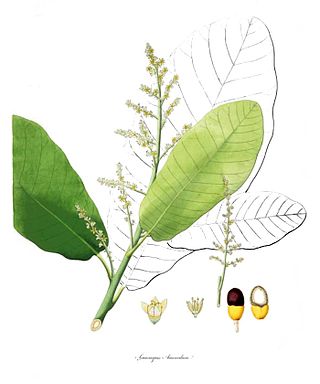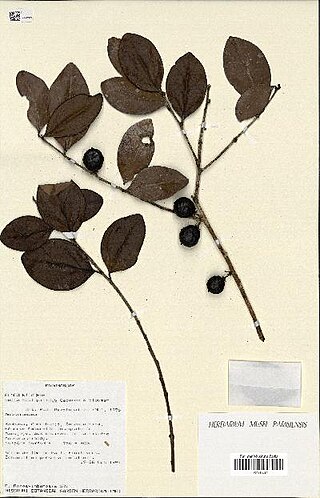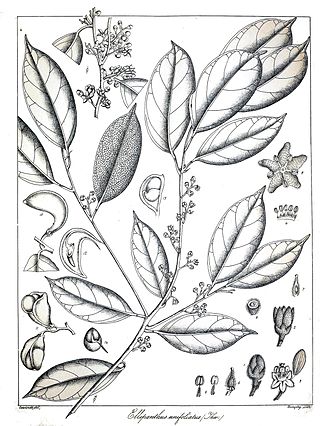
Chaetocarpus is a plant genus of the family Peraceae, formerly Euphorbiaceae, first described as a genus in 1854. Chaetocarpus species are trees or shrubs. They are native to the Americas, Africa, and Asia. Some species are endangered.
- Chaetocarpus acutifolius(Britton & P.Wilson) Borhidi – Sierra de Moa in Cuba
- Chaetocarpus africanusPax – C Africa
- Chaetocarpus castanocarpus(Roxb.) Thwaites – SE Asia, Yunnan, Assam, Bangladesh, Sri Lanka
- Chaetocarpus cordifolius(Urb.) Borhidi – Cuba, Hispaniola, Jamaica
- Chaetocarpus coriaceusThwaites – Sri Lanka
- Chaetocarpus cubensisFawc. & Rendle – Cuba
- Chaetocarpus echinocarpus (Baill.) Ducke – Bolivia, Brazil
- Chaetocarpus ferrugineusPhilcox – Sri Lanka
- Chaetocarpus gabonensisBreteler – Gabon
- Chaetocarpus globosus(Sw.) Fawc. & Rendle – Jamaica, Cuba, Dominican Rep.
- Chaetocarpus myrsinitesBaill. – Bolivia, Brazil
- Chaetocarpus parvifoliusBorhidi – Cuba
- Chaetocarpus pearceiRusby – Bolivia
- Chaetocarpus pubescens(Thwaites) Hook.f. – Sri Lanka
- Chaetocarpus rabarabaCapuron – Madagascar
- Chaetocarpus schomburgkianus(Kuntze) Pax & K.Hoffm. – Colombia, Venezuela, 3 Guianas, NW Brazil

Colubrina is a genus of about 30 species of flowering plants in the family Rhamnaceae, native to warm temperate to tropical regions of Africa, the Americas, southern Asia, northern Australia, and the Indian Ocean islands.
René Paul Raymond Capuron was a French botanist. Capuron was responsible for an extensive amount of work on the tree flora of Madagascar. Several tree taxa with the specific epithet of capuronii honor his name, examples being Podocarpus capuronii and Schizolaena capuronii.

Dialium is a genus of flowering plants in the family Fabaceae, subfamily Dialioideae. Velvet tamarind is a common name for several species. The genus includes 37 species which range from the tropical Americas to sub-Saharan Africa, Madagascar, India, Indochina, and western Malesia.

Campnosperma is a genus of rainforest trees in the Cashew Family (Anacardiaceae). They are found in the East Indies, south Asia and the Seychelles.

Erythrophysa is a genus of plant in the family Sapindaceae.

Gaertnera is a genus of flowering plants in the family Rubiaceae. There are at least 85 species distributed across the Old World tropics from Africa to Asia.

Semecarpus is a genus of plants in the family Anacardiaceae. It includes 87 species native to the Indian subcontinent, Indochina, Malesia, Taiwan, Papuasia, Queensland, and the South Pacific.

Walsura is a genus of plants in the family Meliaceae.

Lepisanthes is a genus of 31 species of trees or shrubs native to tropical Africa, south and southeast Asia, Australia, and Madagascar.

Dodonaeoideae is a subfamily of flowering plants in the soapberry family, Sapindaceae.

Pteroceras is a genus of flowering plants from the orchid family, Orchidaceae. It is native to China, the Indian Subcontinent, and Southeast Asia.

Ludia is a genus of flowering plants in the family Salicaceae.
Malagasia is a monotypic genus of trees in the family Proteaceae. The sole species is Malagasia alticola, endemic to Madagascar.

Ellipanthus is a genus of plants in the family Connaraceae. The generic name is from the Greek meaning "defective flower", referring to the incomplete development of some of the stamens.
Rhopalocarpus is a genus of plants in the family Sphaerosepalaceae. Most species are trees and all are endemic to Madagascar. The generic name is from the Greek meaning "club fruit", referring to the fruit shape.

Filicium decipiens, called the ferntree, fern tree or fern leaf tree, is a species of Filicium found in east Africa, Madagascar, India and Sri Lanka. It is planted as an ornamental tree in the Indian subcontinent, Indonesia, Hawaii, and elsewhere.

Allaeanthus is a genus of flowering plants belonging to the family Moraceae.

Plagioscyphus is a genus of flowering plants in the family Sapindaceae. Its native range is Madagascar.
Pseudopteris is a genus of flowering plants in the family Sapindaceae, native to Madagascar, whose species include:
















